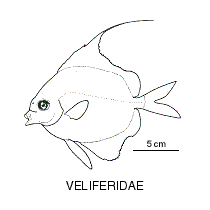- Classification
- ACTINOPTERYGII
- LAMPRIDIFORMES
- VELIFERIDAE
-
Fish Classification
-
Class
ACTINOPTERYGII Ray-finned fishes -
Order
LAMPRIDIFORMES Opahs, ribbonfishes -
Family
VELIFERIDAE Veilfins
Family VELIFERIDAE
A small family of compressed, deep-bodied fishes with high long-based dorsal and anal fins bearing basal scaly sheaths, small weakly attached cycloid scales, rounded pectoral fins and a small, highly protrusible mouth that lacks teeth. The only lampridiform family to regularly inhabit coastal seas.
More Info
|
Family Taxonomy |
A small family found in the Indo-Pacific with 2 monotypic, moderately deepwater genera; both genera occur in Australian waters. Walters (1960) reviewed family, but others questioned validity of recognizing separate genera (Olney 1999). |
|
Family Distribution |
Tropical and subtropical waters of the Indo-Pacific; only lampridiform group to inhabit shallow to moderate depths on the continental shelf at about 30-200 m. |
|
Family Description |
Meristic features: Pelvic fins no spine, 7-9 rays; Branchiostegal rays 6; Vertebrae 33-34 (16 + 17-18). Body deep, strongly compressed, eye large, greater than snout length; mouth small, upper jaw highly protrusible, maxilla protruding freely along with premaxilla, teeth absent. Dorsal and anal fins high, long-based, anterior rays somewhat symmetrical, anterior rays longest; fin rays somewhat retractable into well-developed scaly sheaths at fins bases. Pectoral fins rounded, pelvic fins with no spine and 7-9 rays, inserted below the pectoral-fin base; caudal fin prominent, deeply forked. Scales small, cycloid, weakly attached, absent from snout. |
|
Family Size |
To a length of about 40 cm. |
|
Family Feeding |
Presumably carnivorous feeding on small invertebrates. |
|
Family Reproduction |
Little is known of the reproduction and life history of velifers. The sexes are separate, fertilisation is external and the eggs and larvae are pelagic. Eggs have not been described, and the larvae are poorly known. Larvae are slender, and possess fully developed, protrusible jaws, functional differentiated guts and pigmented eyes at hatching, and, along with Opahs, possess a single predorsal element. |
|
Family Commercial |
Taken as bycatch in commercial fisheries. |
|
Family Conservation |
IUCN: Not evaluated |
|
Family Remarks |
The name Veliferidae is from the Latin velifer, meaning 'sail-bearing' in relation to the tall dorsal and anal fins of these fishes. |
|
Author |
Dianne J. Bray |
References
Olney, J.E. 1984. Lampridiformes: development and relationships. Pp. 368-379, In Moser, H.G., W.J. Richards, D.M. Cohen, M.P. Fahay, A.W. Kendall, Jr. & S.L. Richardson (eds). Ontogeny and Systematics of Fishes. Spec. Publ. No. 1, Amer. Soc. Ichthy. Herpet., ix + 760 pp.
Olney, J.E. 1999. Veliferidae: Velifers, pp. 1966-1967. In Carpenter, K.E. & V.H. Niem. Species identification guide for fisheries purposes. The living marine resources of the western central Pacific. Batoid fishes, chimeras and bony fishes. Part 1 (Elopidae to Linophrynidae). FAO, Rome.
Olney, J.E., G.D. Johnson & C.C. Baldwin. 1993. Phylogeny of lampridiform fishes. Bull. Mar. Sci. 52:137-169.
Olney, J.E. 2005. Regalecidae: Oarfish, pp. 1009-1011, In W.J. Richards (ed). Early Stages Of Atlantic Fishes: An Identification Guide For The Western Central North Atlantic. CRC Press, Taylor and Francis Group, Boca Raton, FL, 2640 pp.
Oelschläger, H.A. 1978. Zur Morphologie und Biomechanik von Agrostichthys Phillips im Verleich mit anderen Allotriognathi (Pisces, Teleostei). Zool. Jahrb. Abt. Anat. 100: 118-153.
Trunov, I.A. 1982. Species of the family Regalecidae (Lampridiformes) from the Southeastern Atlantic. Vopr. Ikhtiol. 22(1): 1-6.
Walters, V. 1960. Synopsis of the lampridiform suborder Veliferoidei. Copeia 1960(3): 245-247.











